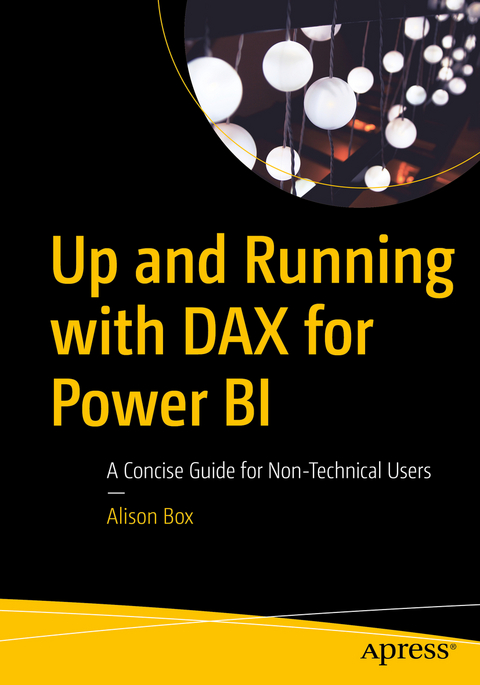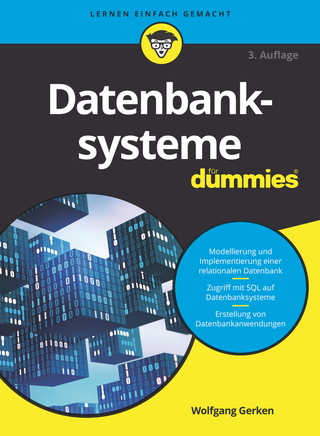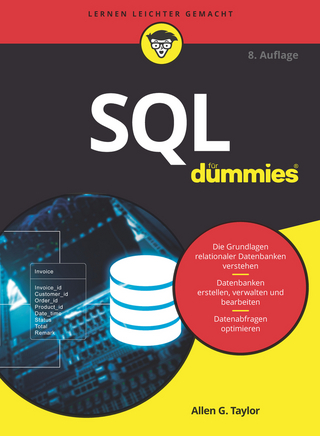
Up and Running with DAX for Power BI
Apress (Verlag)
978-1-4842-8187-1 (ISBN)
While there are numerous resources on DAX, most are written with developers in mind, making learning DAX appear an overwhelming challenge, especially for those who are coming from an Excel background or with limited coding experience. The reality is, to hit the ground running with DAX, it’s not necessary to wade through copious pages on rarified DAX functions and the technical aspects of the language. There are just a few mandatory concepts that must be fully understood before DAX can be mastered. Knowledge of everything else in DAX is built on top of these mandatory aspects.
Author Alison Box has been teaching and working with DAX for over eight years, starting with DAX for PowerPivot, the Excel add-in, before moving into the Power BI platform. The guide you hold in your hands is an outcome of these years of experience explaining difficult concepts in a way that people can understand. Over the years she has refined her approach, distilling down the truth of DAX which is “you can take people through as many functions as you like, but it’s to no avail if they don’t truly understand how it all works.”
You will learn to use DAX to gain powerful insights into your data by generating complex and challenging business intelligence calculations including, but not limited to:
Calculations to control the filtering of information to gain better insight into the data that matters to you
Calculations across dates such as comparing data for thesame period last year or the previous period
Finding rolling averages and rolling totals
Comparing data against targets and KPIs or against average and maximum values
Using basket analysis, such as “of customers who bought product X who also bought product Y”
Using “what if” analysis and scenarios
Finding “like for like” sales
Dynamically showing TopN/BottomN percent of customers or products by sales
Finding new and returning customers or sales regions in each month or each year
Who This Book Is For
Excel users and non-technical users of varying levels of ability or anyone who wants to learn DAX for Power BI but lacks the confidence to do so
Alison Box is Director of Burningsuit Ltd, and an IT trainer and consultant with over 30 years of experience delivering computer applications training to all skill levels, from basic users to advanced technical experts. Currently, she specializes in delivering training in Microsoft Power BI Service and Desktop, Data Modeling, DAX (Data Analysis Expressions), and Excel. Alison also works with organizations as a DAX and Data Analysis consultant. She was one of the first Excel trainers to move into delivering courses in Power Pivot and DAX, from where Power BI was born. Part of her job entails promoting Burningsuit as a knowledge base for Power BI and includes writing regular blog posts on all aspects of Power BI that are published on her website.
Chapter 1: Show Me the Data.- Chapter 2: DAX Objects, Syntax & Formatting.- Chapter 3: Calculated Columns & Measures.- Chapter 4: Evaluation Context.- Chapter 5: Iterators.- Chapter 6: The CALCULATE Function.- Chapter 7: DAX Table Functions.- Chapter 8: The ALL Function and All its Variations.- Chapter 9: Calculations on Dates: Using DAX Time Intelligence.- Chapter 10: Empty Values Versus Zero.- Chapter 11: Using Variables: Making Our Code More Readable.- Chapter 12: Returning Values in the Current Filter.- Chapter 13: Controlling the Direction of Filter Propagation.- Chapter 14: Working with Multiple Relationships Between Tables.- Chapter 15: Understanding Context Transition.- Chapter 16: Leveraging Context Transition.- Chapter 17: Virtual Relationships: the LOOKUPVALUE and TREATAS Functions.- Chapter 18: Table Expansion.- Chapter 19: The CALCULATETABLE Function.
| Erscheinungsdatum | 30.05.2022 |
|---|---|
| Zusatzinfo | 254 Illustrations, color; 2 Illustrations, black and white; XX, 367 p. 256 illus., 254 illus. in color. |
| Verlagsort | Berkley |
| Sprache | englisch |
| Maße | 178 x 254 mm |
| Themenwelt | Mathematik / Informatik ► Informatik ► Datenbanken |
| Mathematik / Informatik ► Informatik ► Software Entwicklung | |
| Mathematik / Informatik ► Mathematik | |
| Schlagworte | All and ALLSELECTED • Calculate • context transition • DAX for beginners • DAX made simple • DAX time intelligence • evaluation context • expanded tables • filter context • row context • SELECTEDVALUES • SUMX |
| ISBN-10 | 1-4842-8187-X / 148428187X |
| ISBN-13 | 978-1-4842-8187-1 / 9781484281871 |
| Zustand | Neuware |
| Informationen gemäß Produktsicherheitsverordnung (GPSR) | |
| Haben Sie eine Frage zum Produkt? |
aus dem Bereich


